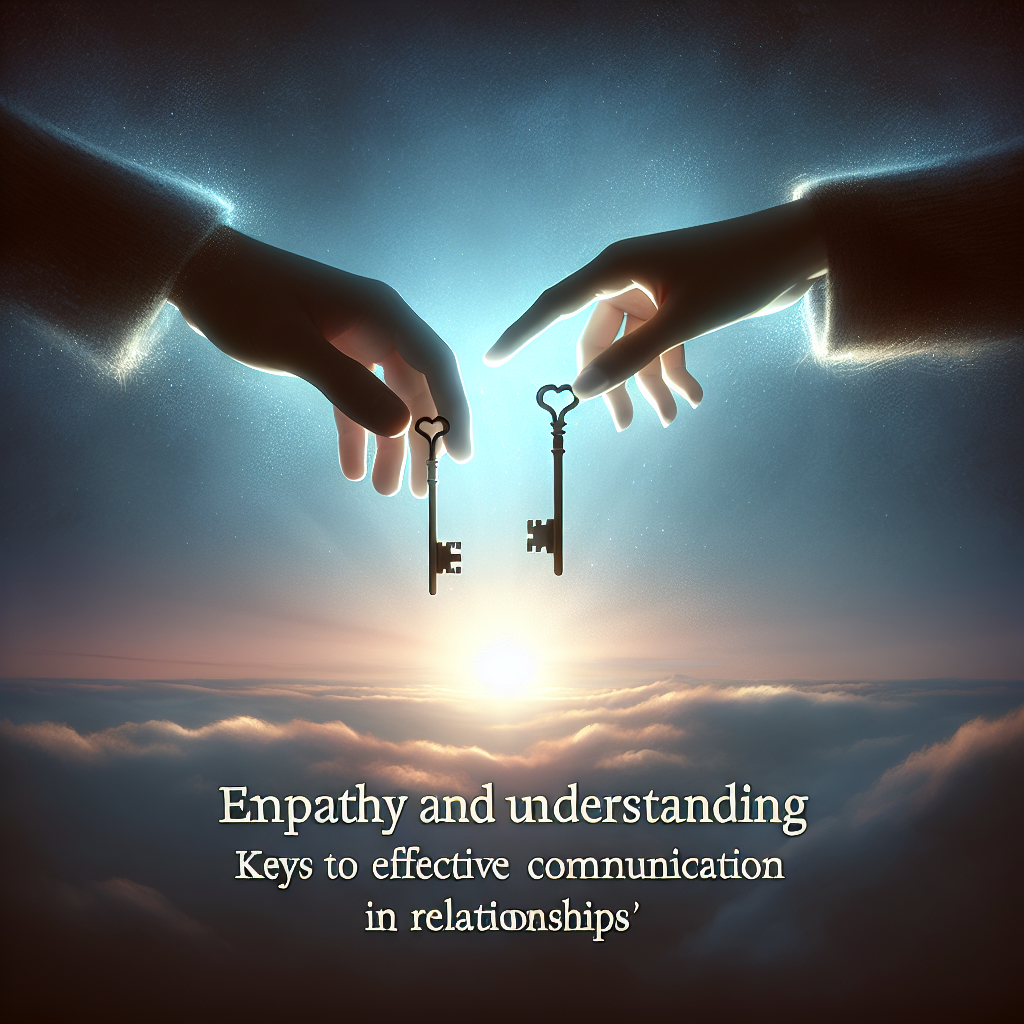Empathy and Understanding: The Ultimate Keys to Effective Communication in Relationships
Introduction
In a world filled with distractions and rapid-fire exchanges of information, the ability to connect deeply with others has never been more essential. Imagine being in a dispute with a loved one, each escalating the conflict with assumptions and harsh words. Now, picture the transformative power of stepping back, seeking to understand, and genuinely empathizing with their feelings. This simple act can turn a tense moment into a meaningful dialogue, paving the path to resolution and deeper connection.
Empathy and understanding are not just buzzwords; they are the ultimate keys to effective communication in relationships. As we explore these concepts in detail, we uncover how they can reshape our interactions and elevate our connections.
The Foundations of Empathy and Understanding
What is Empathy?
Empathy is the ability to put oneself in someone else’s shoes—comprehending their feelings and perspectives without judgment. It goes beyond sympathy; it’s about connecting with others on an emotional level, often leading to greater intimacy and trust.
The Role of Understanding in Relationships
While empathy involves feeling with someone, understanding involves cognitive processing. It’s the conscious act of listening and interpreting what another person is trying to communicate. Together, empathy and understanding create a synergy that fosters effective communication, essential in any relationship.
The Connection Between Empathy and Understanding
To illustrate their interconnectedness, consider this: empathy may evoke feelings of compassion, while understanding offers clarity on the situation at hand. Together, they form a solid foundation for open dialogue, conflict resolution, and mutual respect.
Why Empathy and Understanding Matter
Reducing Conflict and Miscommunication
Misunderstandings can erupt into conflicts that harm relationships. When parties involved practice empathy and understanding, they often de-escalate tensions, leading to more constructive discussions.
| Scenario | Without Empathy | With Empathy and Understanding |
|---|---|---|
| Disagreement over chores | Accusations lead to conflict | Partners express feelings and find solutions |
| Misinterpretation of tone | Hurt feelings escalate | Clarifying intentions fosters connection |
Building Trust and Intimacy
Empathy and understanding invite vulnerability, which can strengthen trust. A relationship in which individuals feel seen and heard is more likely to flourish. For example, couples who express their feelings and genuinely listen to each other often report higher levels of satisfaction.
Enhancing Emotional Intelligence
When individuals cultivate empathy and understanding, they develop a more nuanced emotional intelligence. This capability not only improves personal relationships but also affects professional dynamics, leadership, and teamwork.
Practical Strategies for Developing Empathy and Understanding
1. Active Listening
Case Study: The Smith Family
The Smiths faced growing tensions during family gatherings due to misunderstandings. They decided to implement "listening circles," taking turns to share their perspectives without interruption. This practice led to a significant reduction in conflicts, proving that active listening enhances empathy and understanding.
Why It Works: Active listening involves focusing completely on the speaker, acknowledging their feelings, and responding thoughtfully. This creates a safe space for open communication.
2. Validating Emotions
Validation involves acknowledging someone’s feelings as legitimate. Even if you disagree, recognizing that emotions are real and worthy can diffuse tension.
Example Scenario: Instead of saying, "You shouldn’t feel that way," try, "I understand why you feel that way. It’s a tough situation."
3. Asking Open-Ended Questions
Encouraging the other person to elaborate can deepen understanding. Questions like "How did that make you feel?" or "What do you think we can do about this?" stimulate deeper dialogue.
Case Study: Workplace Dynamics at ABC Corp
At ABC Corp, team conflicts were resolved by encouraging team members to ask open-ended questions during discussions. This shift led to a noticeable improvement in teamwork and morale.
4. Practicing Empathy in Daily Life
Integrate empathy into your daily conversations. Try to express your understanding of others’ feelings and thoughts, particularly when disagreements arise.
| Daily Practice | Impact on Communication |
|---|---|
| Acknowledging a friend’s stress | Strengthens emotional support |
| Recognizing a partner’s hard day | Fosters connection and intimacy |
5. Learning from Conflicts
Reflecting on past conflicts can provide insights into how empathy and understanding failed or succeeded. Analyze the situation and identify what could have been done differently.
Importance of Reflection: This allows both parties to understand triggers and responses, paving the way for healthier communication in future disagreements.
Frequently Asked Questions
1. What are the signs of lacking empathy in a relationship?
Signs may include consistent criticism, failing to acknowledge one another’s feelings, or dismissing concerns. This can lead to more serious issues if left unaddressed.
2. How can I increase my empathy?
Practicing mindfulness, engaging in active listening, and exposing yourself to diverse perspectives through literature or conversations can enhance your empathetic abilities.
3. What if my partner doesn’t practice empathy?
Approach the theme gently in conversation. Share specific examples where their lack of empathy affected you, and express a desire for both of you to improve communication.
4. Can empathy be learned?
Absolutely! While some may be more naturally empathetic, people can develop these skills through practice, self-awareness, and education.
5. What role does culture play in empathy and understanding?
Cultural differences can shape how individuals understand emotions and express empathy. Awareness and willingness to learn about these differences are vital for effective cross-cultural communication.
Conclusion
Empathy and understanding are not merely tools for avoiding conflict; they are gateways to human connection, resilience, and growth. Nurturing these qualities enhances our ability to communicate effectively, ultimately leading to more profound, richer relationships.
As you finish reading, consider how you can infuse more empathy and understanding into your interactions. Start small—practice active listening today, validate a loved one’s feelings tomorrow, and watch as your communication blooms. By embracing empathy and understanding, you are not just improving your communication; you are enriching your life and the lives of those around you.
Empathy and understanding: keys to effective communication in relationships—hold these close, and let them guide your journey toward deeper, more meaningful connections.

